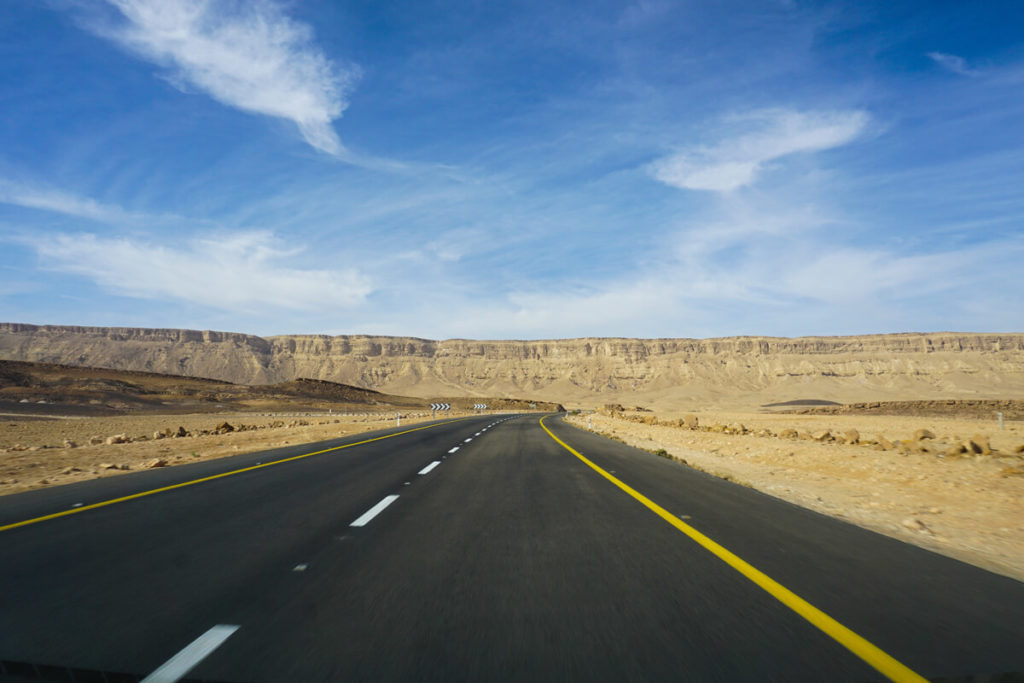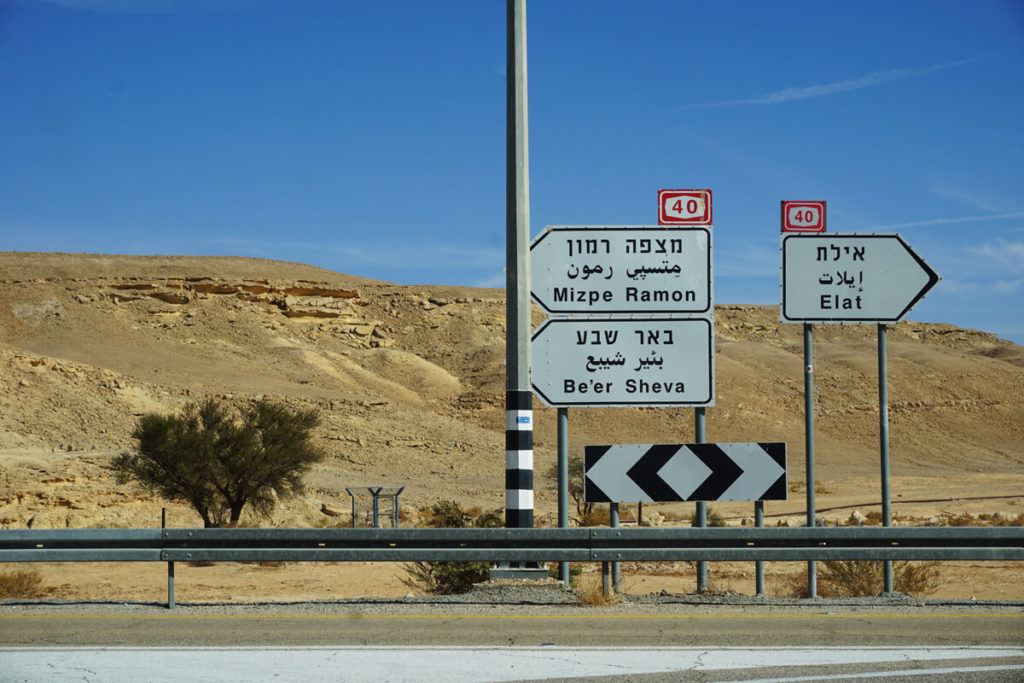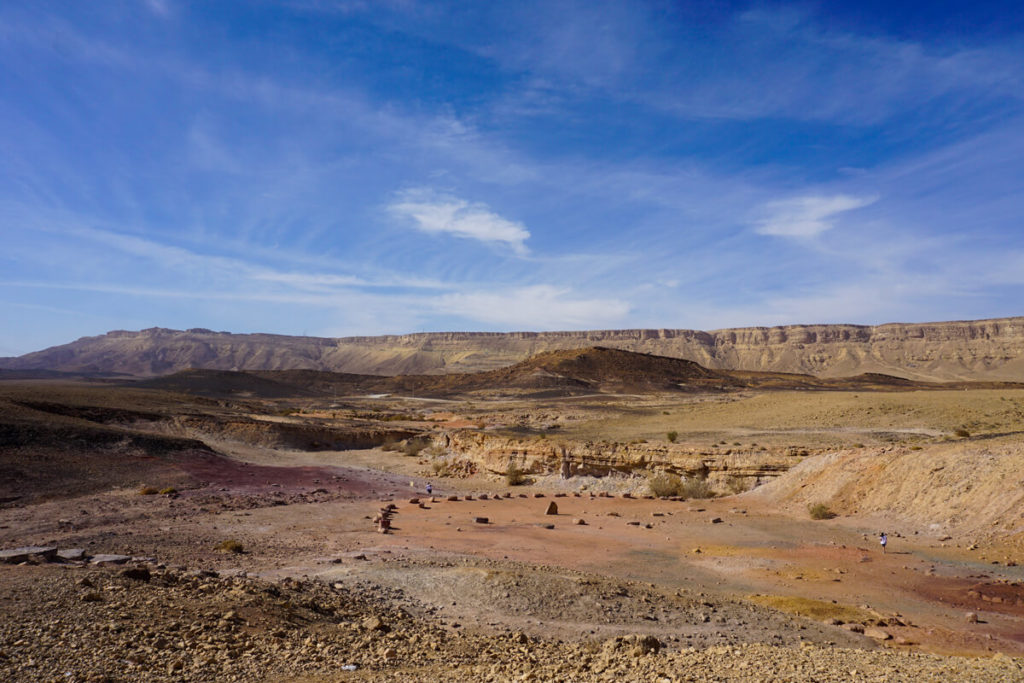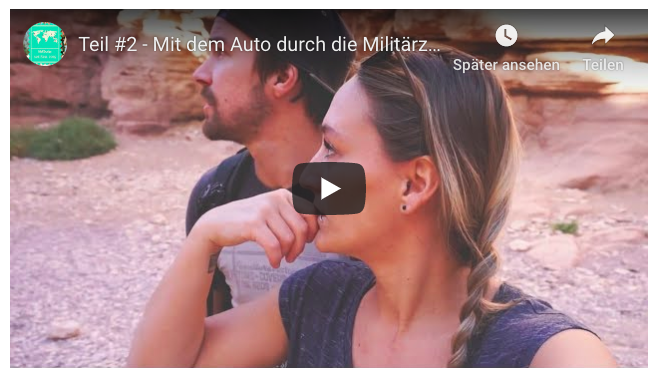Israel just keeps coming up with a new surprise. From the Red Canyon, we set off towards the Maktesh Ramon Crater in the Negev Desert. We passed through seemingly desolate lands, barren crater landscapes, ancient sites, and fertile oases. These landscapes have a very special appeal for us. On the one hand, you don’t see such areas every day, and on the other, we find this rocky desert simply beautiful. But it’s all in the eye of the beholder.

Caution! Military Firing Zone!
Almost 130 kilometers separated us from our next destination – the largest erosion crater in the world. We stayed on Highway 12 and left it near Neot Semadar to continue on Highway 40. For a long time, not much happened on the road until we entered a military zone. At some point, we saw warning signs reading “Firing Zone.”
Now we repeatedly passed huge tanks with missiles, soldiers with machine guns, and small and large military camps. While Marco reacted completely calmly, I was starting to get nervous. You hardly ever see any military in Germany—and certainly not tanks.

Of course, one wonders whether this is normal or whether there is some reason for this mobilization. But considering that in Israel, practically EVERYONE has to serve the military (regardless of whether they are men or women), it’s no surprise that sees them everywhere. Only in a few exceptional situations can one refuse military service.
As we slowly got used to the sight and drove another 30 kilometers through the military zone, we finally reached the heart of the Ramon Crater. As mentioned above, with a length of 40km, a depth of 400 meters, and a width of 2-10km, it is the largest erosion crater in the world. It probably formed 220 million years ago, when the land was still covered by sea.
The beautiful Negev Desert
We stopped at a parking lot and looked around a bit. For miles around, there was really nothing but barren landscape, with crater walls rising steeply from the ground in front of us. The sight amazed us, because this “barren plain” in the Negev Desert has something magical for us.

Around 40 different desert animals live here, including snakes, rodents, porcupines, lizards, scorpions, and even turtles. We would have loved to see a turtle here in the desert—it’s a funny sight, really. Many visitors hike in this region, ride mountain bikes, or drive an off-road vehicle.
The Ramon Crater in Mitzpe Ramon
We continued on to Mitzpe Ramon, a small town on the rim of the crater. From there, we hoped to enjoy a unique panoramic view. At the visitor center, we picked up a map of the area with all the major hiking trails. You can start right there and walk along the crater rim.

The visitor center also features an exhibition on the geological phenomenon of the crater’s formation and on the Israeli astronaut Ilan Ramon, who died in a fatal accident on the Space Shuttle STS-107 (admission: adults 25 shekels, children 13 shekels).

Activities in and around the Ramon Crater:
- Hikes through the crater and the Negev Desert
- Hiking routes and maps in the information center
- Highlights: “Colored Sands”, the “Carpentry” and the oasis “Ein Saharonim”
- Mini-Zoo Bio-Ramin with native desert animals and plants
- Visit to the Alpaca Farm (to the farm’s homepage)
- Hike through the Ein Avdat National Park
- Abseiling on the crater rim at the visitor center
- Sunrise or sunset from the crater rim (tours e.g. with Abraham Tours)
Detour to the En Avdat National Park
Just 20 km from Mitzpe Ramon is the En Avdat National Park. Here, you’ll find deep, wide gorges cut into the soft, white limestone. The oasis also features natural pools, small waterfalls, caves, and patches of lush green vegetation. We have to admit that we arrived too late and unfortunately didn’t get to explore this place. However, the many online pictures make it look truly beautiful.

We were told at the entrance that we should plan on 2 to 3 hours for the hike. Most of the trail has only a slight incline and is therefore not particularly strenuous. The climb to the upper entrance is somewhat steeper up the rock face, but is made easier in places by climbing aids and steps. You should still be free from vertigo! The park is open from April to September from 8 a.m. to 5 p.m., and in winter (October to March) only until 4 p.m.
Last admission is one hour before closing. Adults pay 27 shekels (just under €7), children 14 (€3.50). Drive from Mitzpe Ramon toward Be’er Sheva. There’s a turnoff toward Ben-Gurion’s Tomb, which you follow downhill to the parking lot. Caution: It gets really crowded there on holidays and Shabbat!
Getting to the Mitzpe Ramon Crater
From Eilat, take Route 90 and drive towards Beer Sheva. Then turn left onto Route 40. Eventually, you’ll be in the middle of the crater; just keep following the road. From Eilat to the visitor center in Mitzpe Ramon, it’s about 150 kilometers. From Tel Aviv, first take Route 6 and then Route 40 towards Beer Sheva. It’s just under 200 kilometers to the crater. Even from Jerusalem, it’s unfortunately quite far (3 hours drive). You first take Highway 1 toward Tel Aviv, then turn onto Highway 6 and later onto Highway 40, always heading toward Beer Sheva.
